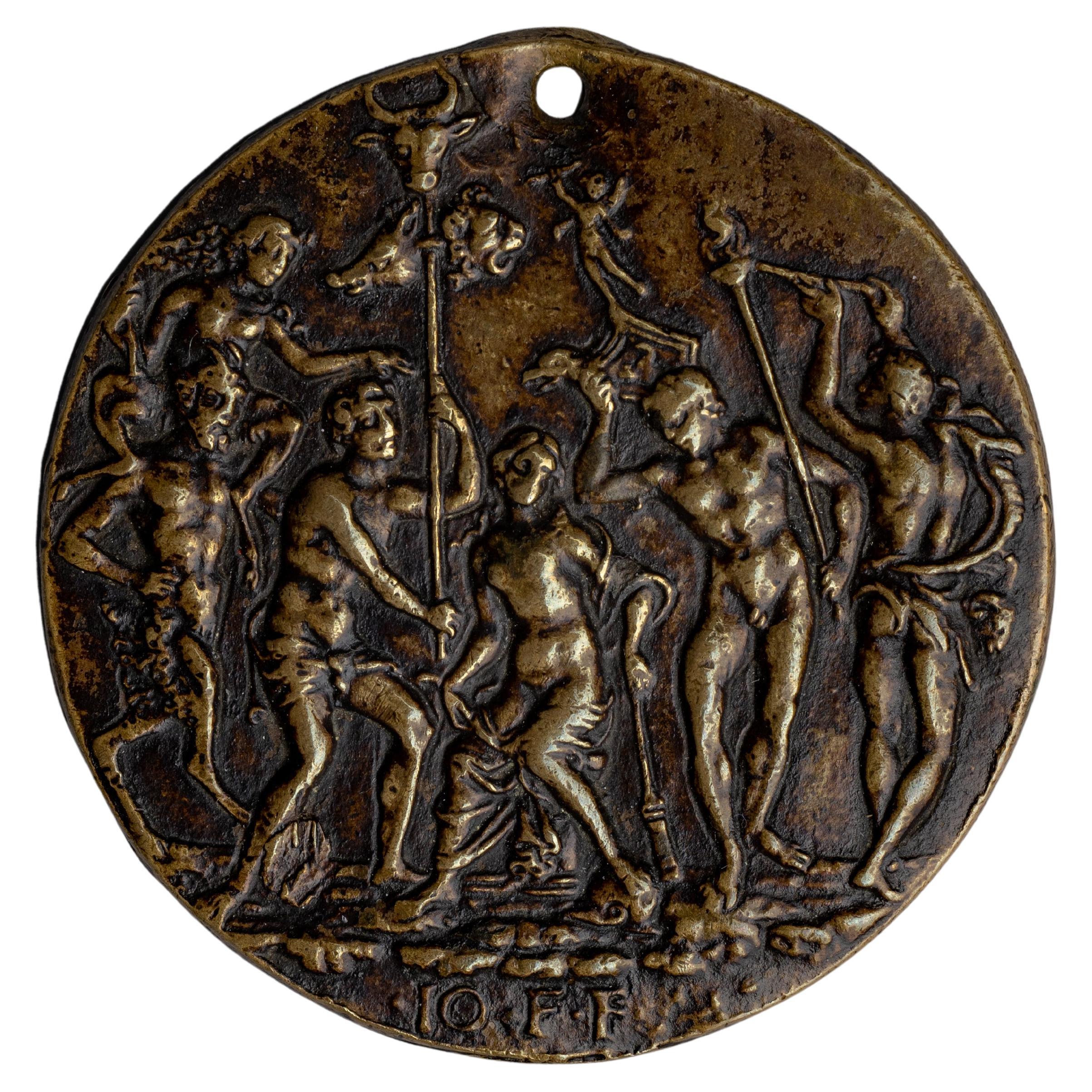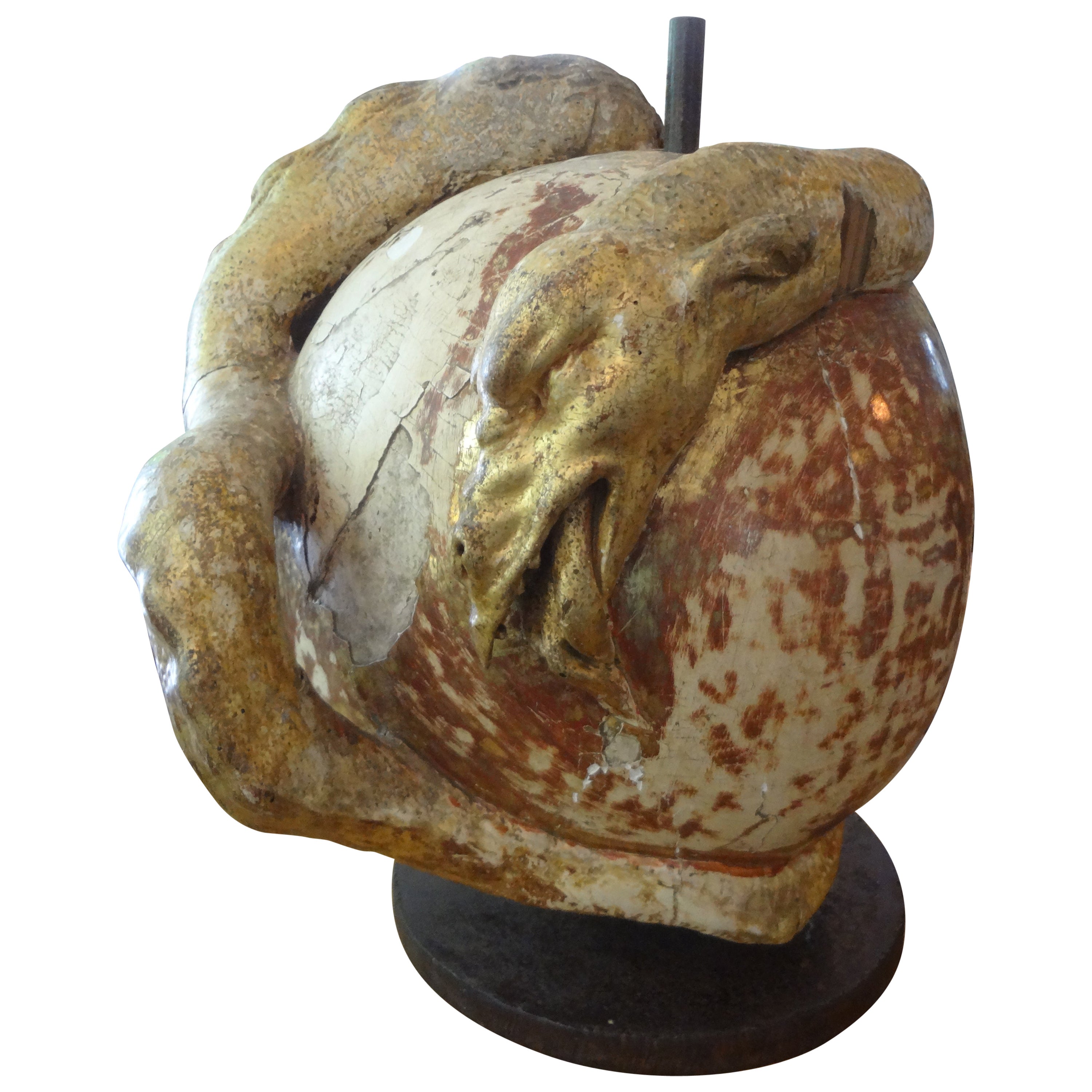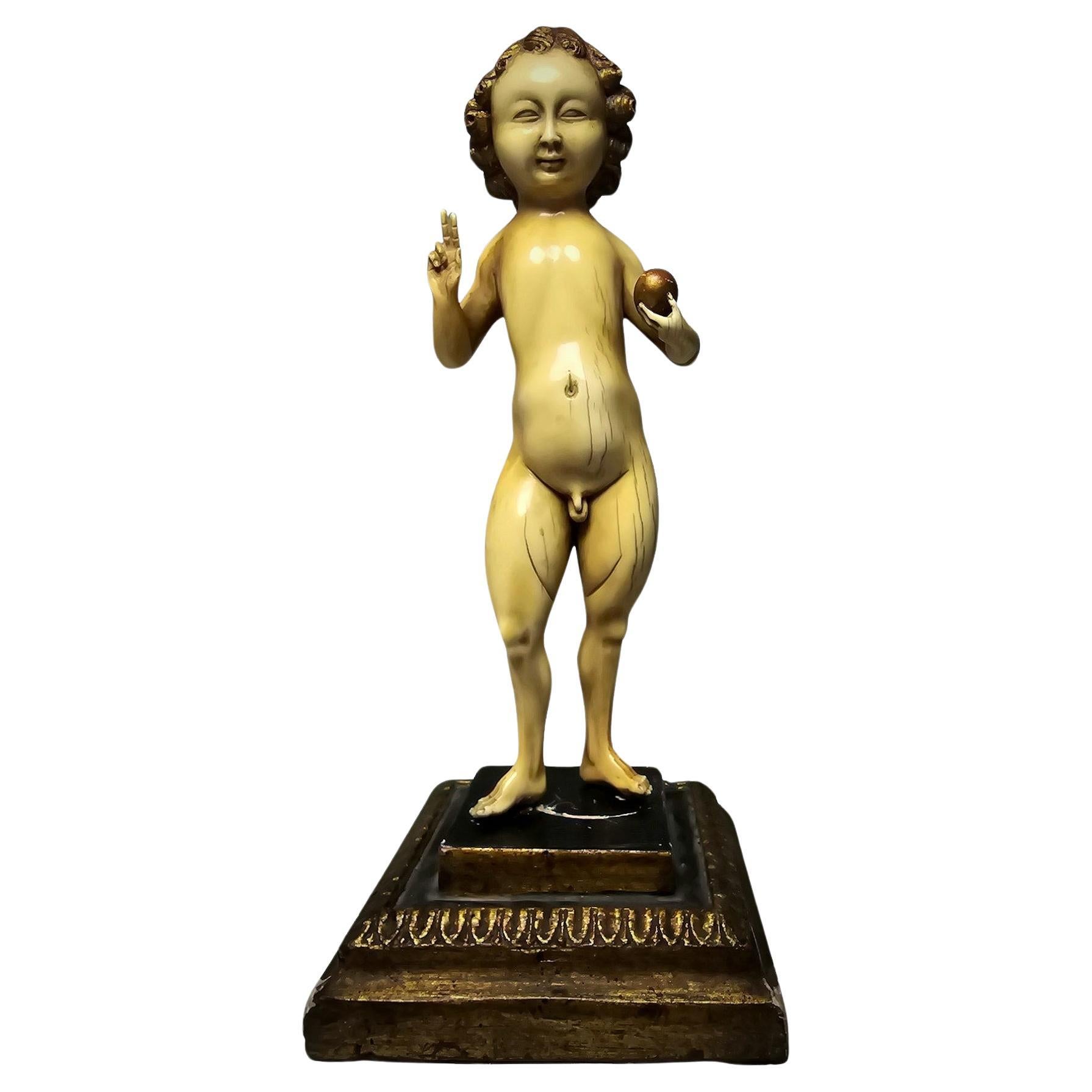Items Similar to Terracotta Bust of Christ as the Redeemer, 15th Century
Want more images or videos?
Request additional images or videos from the seller
1 of 6
Terracotta Bust of Christ as the Redeemer, 15th Century
About the Item
A terracotta bust of Christ as The Redeemer
Tuscany or Emilia Romagna, late 15th century
Measures: 46 x 43 x 21 cm
This powerful, moving bust of Christ as the Redemeer is characteristic of a type of terracotta statuary that flourished in the second half of the 15th century in Emilia-Romagna and Tuscany.
This beautifully executed Christ assumes a doleful position with drops of bloods descending from his foreheads, looking down with heavy and large almond-shaped eyes and a slightly open mouth.
The symmetrical facial features, domed forehead, long face, central parting of the hair and gently pointed forked beard of this bust of Christ, are ultimately derived from Verrocchio's celebrated figure of the Redeemer from his monumental Christ and St. Thomas bronze group on Orsanmichele in Florence, which was begun in 1467.
This conception became one of the canonical models for Christ, profoundly influencing generations of Italian artists long after Verrocchio's death.
However, unlike the Verrocchio model, the present figure of Christ faces forwards, with no tilt to the head.
The hair is also more irregular, the strands are intertwined and the curls falling nervously from the domed head, to his shoulders, a late 15th-century fashion seen in two busts in the Victoria and Albert Museum.
Related literature :
- C. Avery, Fingerprints of the Artist: European Terra-Cotta Sculpture from the Arthur M. Sackler Collections, Cambridge, 1981, pp. 28-30, no. 1.
-G. Bonsanti and F. Piccinini, Emozioni in terra cotta, exhibition catalogue, Modena, 2009, pp. 208-209, no. 52.
- A. Butterfield, The Sculptures of Andrea del Verrocchio, New Haven and London, 1997, pp. 56-80
-J. Pope-Hennessy, Catalogue of Italian Sculpture in the Victoria and Albert Museum. Volume I: Text. Eighth to Fifteenth Century, London, 1964, pp. 205-207
- V. Sgarbi, Tra classicismo, naturalismo ed espressionismo, in la scultura al tempo di Andrea Mantegna
- Superbi Gioffredi, Verrocchio and Late Quattrocento Italian Sculpture, Florence, 1992, p. 129, fig. 90.
- Dimensions:Height: 18.12 in (46 cm)Width: 16.93 in (43 cm)Depth: 8.27 in (21 cm)
- Style:Renaissance (Of the Period)
- Materials and Techniques:
- Place of Origin:
- Period:
- Date of Manufacture:15th Century
- Condition:Wear consistent with age and use.
- Seller Location:Bruxelles, BE
- Reference Number:1stDibs: LU6666231859032
About the Seller
5.0
Vetted Seller
These experienced sellers undergo a comprehensive evaluation by our team of in-house experts.
1stDibs seller since 2022
6 sales on 1stDibs
Typical response time: 7 hours
- ShippingRetrieving quote...Ships From: Bruxelles, Belgium
- Return PolicyA return for this item may be initiated within 3 days of delivery.
More From This SellerView All
- Ecce Homo - Florence, 15th centuryLocated in Bruxelles, BEA terracotta bust "Ecce Homo" Florence, 15th century 53 x 44 x 31 cmCategory
Antique 15th Century and Earlier Italian Renaissance Figurative Sculptures
MaterialsTerracotta
- Gothic Canopy, France, 15th CenturyLocated in Bruxelles, BEGothic canopy France, 15th century Alabaster, some traces of polychromy 33 x 23 x 20 cm Provenance: - Private collection Genève, Switzerland ...Category
Antique 15th Century and Earlier French Gothic Figurative Sculptures
MaterialsAlabaster
- Large Hexagonale Base of Pilaster in Burgundy Stone, Burgundy, 15th CenturyLocated in Bruxelles, BELarge base of molded hexagonal pilaster in burgundy stone carved with vines, grapes and rosettes in high relief. Burgundy, 15th century 28 x 63 x 30 cm Provenance : collection De...Category
Antique 15th Century and Earlier French Gothic Architectural Elements
MaterialsStone
- Gothic Stone Fragment Representing Vine Leaves, France, 15th CenturyLocated in Bruxelles, BEGothic architectural fragment representing vine leaves France, 15th century Sandstone H 21 x 21 x 17 cm mounted on a modern metal pe...Category
Antique 15th Century and Earlier French Gothic Architectural Elements
MaterialsLimestone
- Adoration of the Magi, Flanders, 17th CenturyLocated in Bruxelles, BEThe Adoration of the Magi. Panel carved in high relief. Flanders, 17th century. Measures: 53 x 32,5 cm.Category
Antique 17th Century Dutch Renaissance Figurative Sculptures
MaterialsWood
- Attributed to Domenico di Paris - Madonna and The Child, 15th centuryLocated in Bruxelles, BEAttributed to Domenico di Paris, also called Domenico del Cavallo ( Monselice, documented in Ferrara between 1442 and 1501) Madonna and The Child Polychromed and gilded Stucco 47,5 ...Category
Antique 15th Century and Earlier Italian Renaissance Wall-mounted Sculpt...
MaterialsStucco
You May Also Like
- African Terracotta Equestrian Sculpture, Ghana, 14-15th AD CenturyLocated in Paris, FRExceptional antique African Tribal Art terracotta sculpture representing a rider on his horse. It dates back from the 14th -15th century AD ...Category
Antique 15th Century and Earlier Ghanaian Tribal Figurative Sculptures
MaterialsTerracotta
- Saint John of Calvary, 2nd half of the 15th centuryLocated in PARIS, FRLarge walnut wood sculpture in the round, depicting Saint John in the position he usually has at the foot of Christ on the Cross. Beautifully expressive face, framed by expertly curl...Category
Antique 15th Century and Earlier French Renaissance Figurative Sculptures
MaterialsWalnut
- 15th Century Italian Renaissance Bronze MedallionLocated in Fort Lauderdale, FLRenaissance bronze medallion made by Master IOFF in the mid 15th century, showing the mythological scene of Ariadne on Naxos. Made in the mid-15th ...Category
Antique 15th Century and Earlier Italian Renaissance Mounted Objects
MaterialsBronze
- 15th Century Italian Renaissance Giltwood CarvingLocated in Houston, TX15th Century Italian Renaissance Giltwood Carving . This magnificent 15th century Italian Renaissance gilt wood carving with a serpent is displayed on a revolving iron base. This mou...Category
Antique 15th Century and Earlier Italian Renaissance Mounted Objects
MaterialsIron
- Sculpture of the Infant Jesus as Salvator Mundi - School of Mechelen, 15th-16thLocated in Madrid, ESImmerse yourself in the timeless beauty of this sculpture of the Infant Jesus as Salvator Mundi, an exceptional piece originating from the renowned School of Mechelen of the 15th-16t...Category
Antique 15th Century and Earlier Figurative Sculptures
MaterialsBone
- 15th Century Burgundian Low-Relief Depicting Scenes of the NativityLocated in Saint-Ouen, FRProvenance : In the same private collection for several generations, Burgundy. The canonical Gospels describe briefly the episode of the Nativity. It comprises three parts : • The Preludes : the Journey to Bethlehem, the Census • The Nativity • The Announce to the Shepherds and the Adoration of the Magi Only the Gospel according to Matthew (2, 1-12) speaks about the Adoration of the Magi. Staying vague about their number it does say they brought the newborn gold, incense and myrrh. The apocryphals, the fathers of the Church and many other authors have filled in the gaps of the evangelic tale. The sobriety and symbolic of the story have been a huge inspiration to artists. Although one of the oldest depictions of the Adoration of the Magi dates from the 2nd century the theme became very popular in Christian art during the late 14th century. One of the reasons explaining this success is that it celebrates both the Virgin and Christ at the same time. This important walnut panel is carved in a strong relief and depicts the different steps of the story of Jesus’ birth. On the left, the donkey and ox that have accompanied Mary and Joseph from Bethlehem are depicted behind a trough. On the thatch roof appears the star that would guide the magi to the place of birth of Jesus. Mary is wearing a veil and is seating on a bed. She holds her baby at arm’s length to present him to the magi. Saint Joseph is by her side. The old man is holding a cane in his left hand while from the right hand he seems to uncover himself to greet the visitors. A woman assists to the scene. In front of the holy family the three magi stand behind one another to pay their homage to the newborn. The first magi has a pointed beard. He is already kneeling out of deference and has placed his crown to his feet. He gives the baby a hanap filled with gold coins. This is Melchior as the legend describes him with white hair and a long beard. Caspar, the second magi bears a cup of incense. He is looking at the third magi and with his right hand he points to the star that has guided them there. He has a short beard and wears crakow shoes, breeches and a wide sleeved doublet. Finally Balthazar, the elegant last magi proceeds proudly towards the holy family with his one hand on the saber’s hilt and the other holding a cup. He brings the divine child the myrrh. He probably just dismounted as the horse can be seen behind him. The scene is set in a very detailed and narrative decor. In the right part of the panel the shepherd receive the announce of Jesus’ birth. An angel comes down from heaven with a scroll bearing the good news in his hands. The herding dog sleeps peacefully while sheeps graze. At the top of the cliff we notice the gilded sheeps enclosure. The panel’s moulded frame is carved with a foliated decor. In it’s centre appears a coat-of-arms. It is the alliance of the three magi’s arms. Indeed as it was common for legendary figures the three of them received imaginaries coat-of-arms. Thus, on a field of azure stands a star for Melchior, a crescent for Caspar and a pennon for Balthazar. This high-relief panel is undeniably the work of a very skilled and imaginative artist. This key moment in the New Testament is transposed to a contemporary environment thanks to the figures’ clothing and the rural daily life scene. This way the universal dimension of the episode is highlighted allowing a better understanding for the contemporaries. The sculptor has represented the episodes of the Adoration of the Magi and the Announce to the Shepherd with great talent and numerous details giving life to a picturesque and narrative scene. The important traces of polychromy give those already very animated scenes a stronger pictorial power and a rich dynamism. Because of the picturesque and familiar realism so dear to the artists of the late Medieval era, of the didactic function of this type of panel as well as the quality of the sculpture this piece is an astounding example of Burgundian art of the 15th century. Literature Louis Réau, Iconographie de l’Art chrétien...Category
Antique 15th Century and Earlier French Gothic Figurative Sculptures
MaterialsWalnut
Recently Viewed
View AllMore Ways To Browse
15th Italian
15th Century Italy
15th Century Italian
Italy Christ
15th Century Italian Furniture
Antique Furniture Strand
Christ Unknown
Christ Figure
Renaissance 15th
G Albert
C Terras
Christ Bronze
Bronze Christ
Antique Furniture Cambridge
Emilia Romagna
Italian Renaissance 15th
Italian Renaissance 15th Century
Face Of Christ





